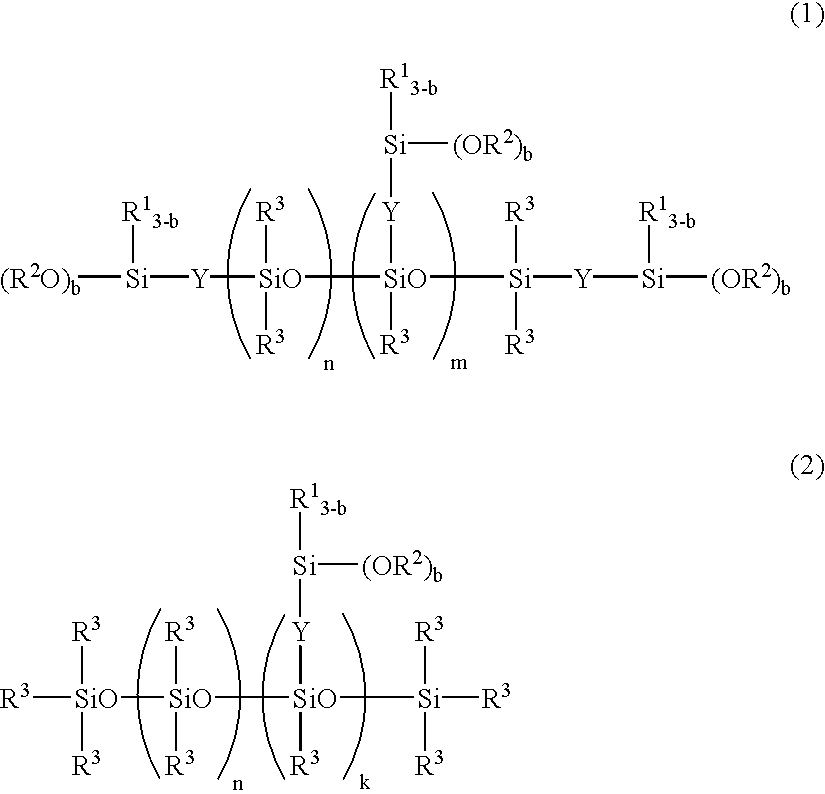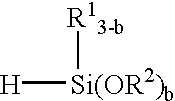Room temperature curable organopolysiloxane compositions
a technology of organopolysiloxane and composition, which is applied in the field of room temperature curable organopolysiloxane compositions, can solve the problems of lack of oil resistance and long-life coolant resistan
- Summary
- Abstract
- Description
- Claims
- Application Information
AI Technical Summary
Benefits of technology
Problems solved by technology
Method used
Image
Examples
synthesis example 1
To 100 parts of α,ω-dimethylvinyl-dimethylpolysiloxane containing two vinyl groups on side chains and having a viscosity of 30,000 cp were added 7 parts of trimethoxysilane and 1 part of a 1% isopropanol solution of chloroplatinic acid as the catalyst. In a N2 gas stream, they were mixed at 80° C. for 8 hours. The mixture was then heated at 50° C. under a vacuum of 10 mmHg, distilling off the excess trimethoxysilane.
The polymer thus obtained had a viscosity of 31,000 cp. When the polymer was mixed with tetrabutyl titanate in a ratio of 100:1, it did not thicken immediately and cured after one day. This suggests that trimethoxysilane added to vinyl groups at ends and side chains of the polymer. This polymer is designated Polymer A and has the average formula shown below.
synthesis example 2
To 100 parts of α,ω-dimethylvinyl-dimethylpolysiloxane having a viscosity of 30,000 cp were added 5 parts of trimethoxysilane and 1 part of a 1% isopropanol solution of chloroplatinic acid as the catalyst. In a N2 gas stream, they were mixed at 80° C. for 8 hours. The mixture was then heated at 50° C. under a vacuum of 10 mmHg, distilling off the excess trimethoxysilane.
The polymer thus obtained had a viscosity of 30,500 cp. When the polymer was mixed with tetrabutyl titanate in a ratio of 100:1, it did not thicken immediately and cured after one day. This suggests that trimethoxysilane added to vinyl groups at ends of the polymer. This polymer is designated Polymer B and has the average formula shown below.
synthesis example 3
To 100 parts of α,ω-dihydroxy-dimethylpolysiloxane having a viscosity of 30,000 cp were added 10 parts of tetramethoxysilane and 0.1 part of isopropylamine as the catalyst. In a N2 gas stream, they were mixed at 100° C. for 6 hours. The mixture was then heated at 50° C. under a vacuum of 10 mmHg, distilling off the excess tetramethoxysilane.
The polymer thus obtained had a viscosity of 30,500 cp. When the polymer was mixed with tetrabutyl titanate in a ratio of 100:1, it did not thicken immediately and cured after one day. This suggests that the polymer ends were substituted with trimethoxysilyl groups. This polymer is designated Polymer C and has the average formula shown below.
PUM
| Property | Measurement | Unit |
|---|---|---|
| molar ratio | aaaaa | aaaaa |
| molar ratio | aaaaa | aaaaa |
| viscosity | aaaaa | aaaaa |
Abstract
Description
Claims
Application Information
 Login to View More
Login to View More - R&D
- Intellectual Property
- Life Sciences
- Materials
- Tech Scout
- Unparalleled Data Quality
- Higher Quality Content
- 60% Fewer Hallucinations
Browse by: Latest US Patents, China's latest patents, Technical Efficacy Thesaurus, Application Domain, Technology Topic, Popular Technical Reports.
© 2025 PatSnap. All rights reserved.Legal|Privacy policy|Modern Slavery Act Transparency Statement|Sitemap|About US| Contact US: help@patsnap.com



